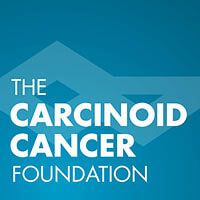Presented by
Nancy Gardner, Ph.D., ARNP
GI Tumor Program
H. Lee Moffitt Cancer Center and Research Institute,
Tampa, FL
Carcinoid Symposium Spring 2002
Tampa, Florida
April 12, 2002
When a patient is diagnosed with carcinoid they begin hearing a lot about the value of measuring a marker such as 5HIAA. They often ask many questions and the most common I hope to address:
What is a biochemical marker? The answer is simple. It is a measurable substance or substances that are produced and released from the tumor cells that indicate tumor cell activity. Specifically, Carcinoid tumor cells contain small clear vesicles that synthesize and release numerous potentially bio-active proteins and hormones. Chromogranin A, Serotonin, Substance P, Histamines, and Gastrin represent some of the most common markers evaluated in carcinoid patients.
What is the clinical significance of tumor markers? (A) They serve as markers for diagnosis and evaluation. Positive immunohistochemical staining for Chromogranin (Cg), Synaptophysin, and Neuron Specific Enolase (NSE) provide necessary evidence for the definitive diagnosis of a tumor of neuroendocrine origin. (B) Positive Ki67 staining provides the pathologist supporting evidence for the grading the tumor. He initially will review biopsy samples under a microscope and in 10 high powered fields he will attempt to count the cells undergoing mitosis. The number of actively dividing cells determines the grade. Tumor grade is a prognostic factor and important in determining the management of the disease. A well differentiated or low grade tumor is slower growing than a poorly differentiated or high grade tumor. (C) The presence of hormonal markers can provide evidence of the site of origin. This is helpful when the patient is diagnosed with metastatic disease and has a primary tumor that is unknown. The sites are divided into: Foregut – Bronchial, Pancreatic, gastric and duodenal carcinoid, Midgut – small bowel, ascending colon and part of transverse colon, and Hindgut the rest of transverse colon, descending and sigmoid and rectal colon. There are differences in behavior of the tumors depending on the site of origin based on differences in elevated hormonal expression. They can express and cause different symptoms and metastasize to different areas. This is important for investigating stage or over all burden of disease.
Are there markers that are unique to Carcinoid tumors and why are their values evaluated? First – Yes there are unique markers associated with carcinoid tumors and vary according to location of primary and their levels are more pronounced in metastatic disease. Second – They Provide clinician with useful information for diagnosis, management, and follow up for disease activity and for symptoms. Chromogranin A is a general marker for neuroendocrine tumors. Serotonin, measured in urine as 5 hydroxyindoleacetic acid (5HIAA), Elevated levels of 5HIAA is correlated with carcinoid syndrome and carcinoid crises. Prolong exposure of the heart valves to high levels of serotonin is associated with complications of the disease. Markers can be unique to the site of origin of the primary tumor. Foregut and Midgut are more often produce abnormal levels of bioactive hormones and proteins. Hindgut Carcinoid tumors are lest often associated with most markers but will express Chromogranin A.
Most commonly measured markers are Chromogranin and 5HIAA. These makers are strongly correlated with tumor burden and often mirror one another in their behavior. Chromogranin A (CgA) is a general marker associated with all carcinoid tumors. It is a protein produced by tumor cells and released. Chromogranin A is associated with other hormones and may be involved in their regulation. It may also be associated with cell adhesion in metastatic disease. It is deposited directly into the vascular compartment and measured in the serum. Its function is not entirely understood; It is not responsible for causing symptoms. There is a normal level of Chromogranin A in the blood, and the range currently is less than 39ng/l.. Abnormal levels can vary form forty to the thousands. The sensitivity of the test for CgA is about 80%, this means that 80% of the time abnormal levels are correctly associated with disease. The specificity of the test is about 95%, this means that 95% of the time if the CgA level is normal and there is no disease present. Chromogranin A levels can be spuriously elevated with sitting up oppose to lying down, hypertension, strenuous activity, pregnancy, Interestingly, we seen often doubling of values prior to radiographic evidence of disease progression, suggesting that doubling of values maybe more prognostic for evaluating progression of disease where elevated levels are prognostic for disease.
Serotonin Precursor- Associated with Foregut tumors and is not readily measured by 24 hour Urine 5HIAA test. Serotonin is most often associated with Midgut tumors and metastatic disease in the liver, and less often associated with Foregut tumors. It is broken down by the liver and excreted as 5HIAA in the urine. Elevated levels are associated with symptoms such as diarrhea, flushing, and edema (Carcinoid Syndrome). Serotonin can also be elevated with the ingestion of foods such as bananas, avocados, pineapple and medications such as coumadin and Tylenol. Chromogranin and Serotonin (5HIAA) levels are independently affected by Sandostatin. 5HIAA levels are reduced more than 70% in reduction in level and symptoms and 5% will achieve normalization of levels with Sandostatin. Chromogranin A is less affected. Both remain good markers for follow up and initial diagnosis.
Substance P another marker associated with Foregut and Midgut tumors. Measured in the blood, abnormal levels are not always associated with noticeable symptoms which herald its presence. It is a vasoactive protein that can cause wheezing, diarrhea, tachycardia, flushing and tenderness associated with subcutaneous nodules without elevated levels of serotonin.
Histamines – Are usually associated with Foregut tumors. Its presence in elevated levels produces a patchy rash on the trunk, back, arms, and legs. It may mimic other allergic symptoms both in appearance and sensation. It is also evaluated for abnormal levels by a 24 urine test call 5HIAA.
Gastrin – Associated with Foregut and Midgut tumors and also measured by a blood test. It produces excess gastric acid and is often associated with a long history of GERD.
Other more obscure markers include ACTH, catecholamines and somatostatin.
In clinical practice, the physician may order Chromogranin A and other markers at time of diagnosis to determine what additional markers to monitor, or the decision may be to wait till symptoms suggest that certain hormones are being abnormally produced and released. Both approaches are reasonable evaluation strategies. Once the significant prognostic markers have been identified, they should be routinely followed in conjunction with radiographic test, symptom history and physical exam to provide the most comprehensive approach to clinical management.
There are several situations that will purposefully reduce the levels of marker hormones and subsequently, reduce associated symptoms and improve quality of life and may impact overall survival. Surgery, either for the resection of the primary tumor of for partial hepatectomy can dramatically reduce levels to normal when disease is no longer observed. Hepatic artery embolization can also dramatically reduce levels and is an important tool for controlling severe elevations of 5HIAA to prevent carcinoid heart disease. Sandostatin also affects the levels of these markers and should be considered when comparing values pre and post Sandostatin use.
High levels of serotonin have been correlated with the development and presence of carcinoid heart disease. Serotonin is release and circulated to the right side of the heart, there it is routed to the liver where it is broken down and excreted by the kidneys as 5HIAA. The blood returning to the left side of the heart has normal levels of serotonin. Carcinoid Heart Disease is a result of thickening of the pulmonic and tricuspid heart valves, as a result of prolonged exposure to high levels. The impact of this is seen in the right side of the heart. The valves become thick and dysfunctional which causes leaking or regurgitation, and if left untreated, may lead to right sided heart failure. Severe carcinoid heart disease is treated with open heart surgery to replace damaged valves with pig or artificial valves.
High levels of serotonin can be released by the tumors when they are manipulated such as during surgery, hepatic artery embolization, palpation of the live during a routine abdominal exam to measure an enlarged liver. Strong emotions and stress can also stimulate these tumor cells to produce and release exaggerated levels of serotonin. Acute high levels can cause an dramatic increase in symptoms, ranging form light headedness, changes in blood pressure, confusion, to loss of consciousness. These symptoms can persist up to 12 hours after a procedure. They can be controlled or recovered with large doses of Sandostatin prior to a procedure, during the procedure, and after the procedure.
It is hypothesized that abnormal hormonal expression, evident by the presence of symptoms prior to diagnosis may impact prognoses. In a retrospective review of approximately 256 carcinoid patients at H. Lee Moffitt Cancer Center in Tampa Florida, the presence of uncontrolled symptoms, a surrogate for abnormal hormone levels, increased the risk of progression of disease and was found to associated with metastatic disease, suggesting more advanced disease. In patients with a history of symptoms and high hormone levels, there was a decreased risk of progression with the use of Sandostatin that reduce hormone levels and control symptoms.
Lowell Anthony published in Digestion. 1996;57(suppl 1):50-53 the results of a study evaluating 5 year survival differences for pre and post Sandostatin. He found a difference in 5 year survival of approximately 40% in favor of the use of Sandostatin to reduce serotonin. These findings support what clinician see in their individual patients.
In summary: Biological markers provide a window to evaluate the disease. They not only hold an importance in diagnosis of disease such as the immunohistochemical staining and Ki67 stain, but in monitoring for disease response either progression of regression due to intervention, and a reliable means of monitoring for levels that may cause additional problems associated with the disease such as carcinoid heart disease and the presence of carcinoid crisis.


